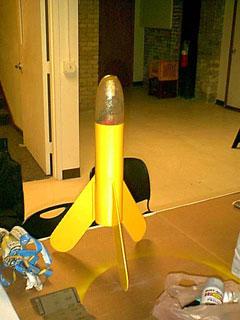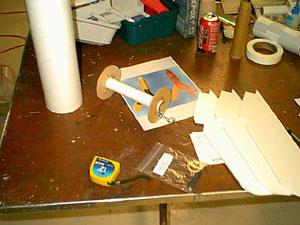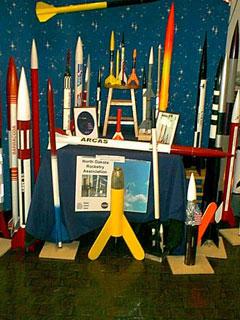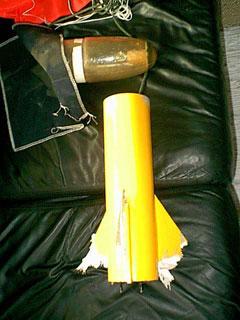Scratch Big Ugly Bug II Original Design / Scratch Built
Scratch - Big Ugly Bug II {Scratch}
Contributed by John Nordlie
| Manufacturer: | Scratch |
 Brief:
Brief:
Big Ugly Bug II (BUB2) is my third scratch-built model rocket, and my second high-power model. After the Big Ugly Bug splattered itself all over the NDRA launch site at Ulland Park, I was a bit discouraged. I stuck with Estes model rocket kits and a few flights with a composite 24mm motor for a while. Eventually I got the bug again, and decided to build my largest high-power yet. Naturally, a scaled-up Mosquito isn't what you'd think of when you think high-power, so naturally that's what I decided to build.
This time I decided to go with commercial rocket parts, since they would be lighter than building my own, and make assembly go more quickly.
 Construction:
Construction:
This time I decided to go with commercial rocket parts, since they would be lighter than building my own, and make assembly go more quickly. I still have to fabricate a nose and fins though.
For fin fabrication, I finally settled on using foam core fins, which were laminated with fiberglass and polyester resin. These were sanded to shape, then the edges filled with auto body filler and sanded to round. Here is an image of the parts before the fins were fiberglassed:
I used through-the-wall mounting to attach the fins to both the body tube and to the 29mm motor mount. After the epoxy had cured I filled the space between the motor mount and the body tube with two-part expanding foam. This adds weight but strengthens the fin mount considerably.
 I was planning on
fabricating a nose cone for this rocket as well, but a friend in the Fargo
rocket club sent me a link to ScotGlas, which makes (among other things)
4" diameter up-scale Mosquito nosecones! The $30 price tag looked like a
better bet than hours in the shop, sanding more fiberglass, so I bought one.
I was planning on
fabricating a nose cone for this rocket as well, but a friend in the Fargo
rocket club sent me a link to ScotGlas, which makes (among other things)
4" diameter up-scale Mosquito nosecones! The $30 price tag looked like a
better bet than hours in the shop, sanding more fiberglass, so I bought one.
Finishing:
I was planning on painting the BUB2 blaze orange, like the BUB. Blaze orange
looks a lot better with a bright yellow undercoat, so after applying grey auto
primer and sanding, I put the yellow on. However, I decided I liked the yellow
so much I skipped the orange. I left the nose unpainted, at the request of
other club members. They want me to put a strobe light in it if/when we ever
have a night launch.
 Flight:
Flight:
On Saturday, March 23, 2002 I made my NAR Level 1 certification attempt. I launched the BUB2 on an Aerotech H128W loaded in a Dr. Rocket 29mm 180 casing (had to borrow the 180 tube from another flier, thanks Mike!). The BUB2 was the first certification flight of the day. It launched with a nice, bright white flame and weathercocked only slightly. The medium delay was perfect, the 'chute deployed, and the rocket landed about 200' down range from the launcher. There was some slight damage to the paint and one fillet was cracked, but the rocket was still flight worthy so the certification group signed off on the flight.
The BUB2 suffered a catastrophic fin failure flying on an Aerotech H180W. Here's the gist of what happened, cut and pasted from an email I sent a fellow HPR enthusiast:
Date: Saturday, April 20, 2002
Subject: Big 'skeeter blues...
(snip)
On launch, the BUB2 weathercocks slightly and heads to the
north-east, just like my H128W certification flight. The bright yellow rocket
is roaring along, spouting a white flame as long as the body
tube, when suddenly, just before burnout and maximum velocity, something goes
catastrophically wrong. In the blink of an eye, where there was once a
cool-looking rocket flying nicely, there is now a huge cloud of bright yellow
debris, fluttering slowly down towards the ground. The majority of the rocket
looks to be still intact, the body tube and nose still attached and the
parachute deployed. The black nomex pad has ripped away and settles to the
ground along with all the other shreds.
What happened? Theories are many, but here is what I think
occurred: On an earlier flight the BUB2 slightly damaged two of the fins near
their root edge. I repaired this with CA adhesive, and it
may or may not have had a role in the failure. A simulation of the BUB2 on an
H180W motor predicts a maximum speed of 257 mph. Since the failure occurred
close to burnout, I suspect that the long, relatively flexible fins started to
flutter at this speed. This caused all three fins to delaminate, shearing at
the foam core (the autobody filler caps didn't lend much strength, they were
mostly for aerodynamics). The unsupported fiberglass skins now underwent
flutter and tore away from the
rocket body. The sudden deceleration this caused made the ballast nose separate
from the rocket body, pulling out the recovery system which deployed at
probably better than 150 mph. That in turn caused the non-stretchable nomex to
tear away from the shock cord. The cord and parachute, being stretchable nylon,
had enough give to absorb the sudden shock and stayed together, allowing all
the 'expensive bits' to come back to the ground relatively undamaged. In fact,
all that really was destroyed was the fins. Unfortunately, they were the only
components I designed and fabricated from scratch. Oh well, lesson learned.
I'll have some images of the shredded rocket on my website soon.
Sponsored Ads
 |
 |











